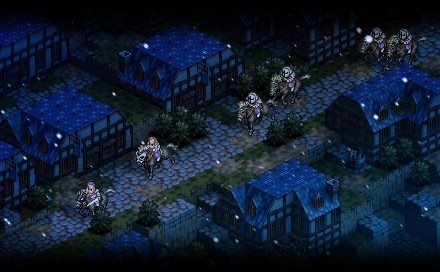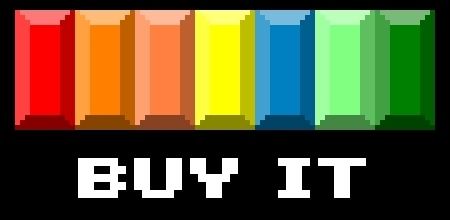
With the artistic elements so strong, you’d imagine this to be a title that compromises its gameplay, but fortunately, that could not be farther from the truth. Although it’s what you would expect from a strategy RPG and the Final Fantatsy Tactics games in particular, you have to keep in mind this is one of the pioneers of the sub-genre. And even if it wasn’t, Tactics Ogre would still stand strong on its own merits, regardless.
The combat takes place on an isometric battlefield, where characters occupy and move over squares, executing attacks one at a time. Each turn, a character may make a movement, take an action, use a skill, or a combination thereof. The terrain is spiced up with town objects like rooftops and castle walls, while in the wilderness, rivers and mountains can limit which kinds of characters can move over certain areas. The difficulty of traversing some of the terrain is compounded by a dynamic weather system which provides for an unpredictable battlefield. Victory is achieved by defeating all enemy units, or at times just their leader, and the layout and nature of the map have a strong influence on the tactics you choose.
Behind the scenes, you customize your army with the class and skill systems. The game has over 30 classes, some of which are unique to certain races or major characters. Classes can be changed fairly easily as there’s no need to level up pre-requisite classes. You simply have to use a classmark, an item that can be purchased at a shop, dropped as loot from a felled enemy, or unlocked under certain story conditions. The most notable aspect of the system is that the units in a class all level up together, so all of your knights or warriors will share the experience gained and will be the same level as one another. This makes it easy to recruit new characters and trust them to be powerful from the get-go, although it can be difficult to level up a new class to your party’s average level, especially crucial roles which only become available later on like the dragoon.
If the classes define your army, the skills are what shape your individual units. Although I previously mentioned that sharing class levels makes it easy to have new characters be powerful from the start, it’s the need to acquire skills that separates the usefulness of new recruits from seasoned veterans. Most skills are available to all characters, but many are unique to specific classes, and include passive abilities like Strengthen (increased strength) as well as commands like being able to use Fire magic. It’s through this system that you can customize what kind of warrior or knight a unit will become: focusing on defense and protecting the weaker units, or going on the offensive to maximize damage when assaulting the enemy. Outside of such archetypes, plenty of quirky options are available, like a fencer who knows almost every kind of magic and is especially strong against faeries. Once you begin getting the hang of it, you can start to coordinate the skills of different units to form attack squads that mutually reinforce each other’s effectiveness. For example, I would have a front line fighter who could make enemyies weak against air magic, then have mages that solely focus on air magic, with abilities that strengthen it, blasting away at the weakened targets. When going up against the harder encounters with the brutish dragons, it pays to have dragon units of your own to stand up to them, a dragoon that can deal out serious damage to them, and a beastmaster who can recruit them once they’re weakened. With over thirty classes, hundreds of skills, and up to fifty recruitable characters, the depth of the system is exceptional.

The tactical thinking required to succeed in many battles really pushes this game to the head of its genre. A lot of strategy RPGs like Final Fantasy Tactics often shed the tactical part of their moniker by mostly becoming about your characters spamming their cheap and overpowered moves as quickly as possible before the enemy can spam their cheap and overpowered moves. While Tactics Ogre does have some exploitable balancing issues, a creative mind often means the difference between victory and defeat. Many of the battles throughout the story are free-XP throwaways that don’t require too much thinking as you can simply take out the overeager and careless leader. However, the more important events are almost always unique challenges where the player really has to don the mantle of a chess player and think several moves ahead. The distinct features of undead units and monsters require completely different approaches than just a human army, and the differences in army composition and attack plans make all the difference. Across all battles, though, the player must adequately calculate when it’s time to defend and when it’s appropriate to attack.
Playing through the story exclusively is fairly straightfoward, although a little bit of grinding is necessary to keep up with the sophistication of the enemies. Conveniently, the game is littered with optional areas and sidequests, so your grinding isn’t as monotonous as constant random encounters. Many of the sidequests give you unique perspectives on the conflict, whether it be a group of refugees who just want to be left alone, or a rebel faction that strongly disagrees with the methods you’ve employed as a result of your decisions. The game also sports numerous challenge areas where you can collect unique items, characters, or classes. A lot of these take the form of a series of battles you must progress in successively: if you leave the area, you have to start over from the first encounter. There are several such places in the game, and the longest one is no less than one hundred levels with only two shops at milestones to restock on items. If the branching storylines with radically different consequences already made this game a completionist’s dream, the astonishing quantity of optional material almost makes it a completionist’s nightmare. All in all, I would not be surprised if Tactics Ogre had at the very least two hundred hours of content.
Tactics Ogre: Let Us Cling Together stands as a masterpiece which reminds us that we don’t have to compromise our expectations of video games. The story, artwork, and music are peerless on their own, but for such a challenging and deep combat system to come along for the ride makes this no less than a perfect title. The fact that there’s just so much of that content here cements that this is a development team of unparallelled talent and dedication. This is the definitive version of a classic, making the Ogre Battle Saga relevant to a new generation of gamers. We can only hope that this means Matsuno, Minagawa, and the rest of the crew will continue working together on either of their legendary RPG universes.

Review Disclosure: A review copy of Tactics Ogre: Let Us Cling Together was provided by Square Enix for the purposes of this review.






